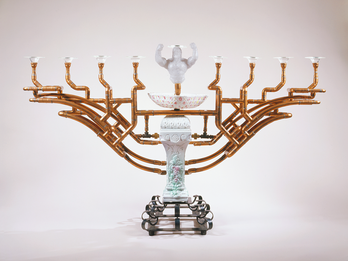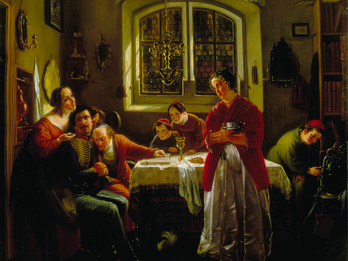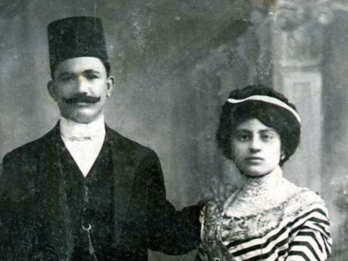
Sample Sources
The sources below are those contained in our three curated collections—covering themes of Passover, Gender Roles, and Holocaust Resistance. They represent a fraction of the thousands of sources that will be available when the full site launches in 2024.

Hanukkah Lamp. Unorthodox Menorah II
Otterson was first inspired to explore the multiple symbolic meanings of the menorah after a trip to Israel in the early 1990s. He made the branches of his reimagined Hanukkah menorah out of copper…

The Return of the Jewish Volunteer from the Wars of Liberation
Moritz Oppenheim’s iconic painting of a Jewish soldier’s homecoming reflects pride, tradition, and ambivalence in an age of emancipation.

Out of Egypt: A Last Passover in Alexandria
A poignant scene depicts André Aciman’s family celebrating their final Passover in Egypt before exile.
“A Culture Stillborn”: The Birth of Levantine Literature
Egyptian Jewish writer Jacqueline Shohet Kahanoff envisions a Levantine literature bridging Middle Eastern life and European culture.
Intra-Jewish Conflict in Israel: White Jews, Black Jews
Scholar Sami Shalom Chetrit analyzes Mizrahi life in Israel through “oppression relations,” revealing how power, race, and assimilation shaped Jewish identity.
“A Simple Girl”: Redefining Mizrahi Womanhood
In “A Simple Girl,” Ayelet Tsabari examines stereotypes of Mizrahi women through Ofra Haza’s 1979 hit “Shir Ha’Freha,” reclaiming voice and identity through her writing.
Jewish Human Rights Group Criticizes Trump’s 2019 Order
A Jewish human rights organization warned that Trump’s 2019 antisemitism order threatened free speech and revived old tropes about Jewish power.
Jewish Identity and Tunisian Independence
Albert Memmi reflects on his support for Tunisian independence and the tensions between nationalism, Zionism, and Jewish identity.

Jewish Dancer at Chicago’s World Fair
This portrait of Jewish dancer Rahlo Jammele is an example of the photographs of diverse people who came from around the world to participate in the 1893 World’s Fair.

Sephardic Women of Tangier: A Portrait
French painter Eugène Delacroix captures two of Tangier’s Sephardic women, Saada and Préciada Benchimol, in this 1832 portrait painted on Préciada’s wedding day.
“To the Modern Girl”: A Rebuke of Modernity
A 19th-century Salonikan writer warns Jewish women about the “modern spirit,” urging virtue over vanity and faith over the empty glitter of modern life.
Letter in al-Hilal: Arguing for Women’s Equality in the Arab World
In this 1890s letter to a leading Arabic literary magazine, Beirut writer Esther Azhari Moyal defends women’s intellect and equality, shaping feminist thought.


